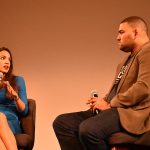
What does the future hold for the humanity? More specifically, what will the world look like in 2050?
Instead of waiting 34 years to find out, Léa Peersman, the lead coordinator for The Future of People conference, decided to reject conventional storytelling and fast forward through the human narrative.
“I’m going to tell you the end first,” Peersman said.
This Saturday, the Massachusetts Institute of Technology Media Lab hosted the first ever The Future of People summit. Experts, luminaries and attendees gathered to facilitate an open conversation about what the future has in store.
“I wanted to build something to help people navigate the 21st century,” Peersman said. “I wanted them to realize their raw potential and the value they have as people.”
Based on Peersman’s methodology to “fast forward, rewind and play,” the conference promoted the exchange of expertise and dialogue to begin enacting change for the future.
Three panels presented in the morning, each drawing conclusions about the future of the human body, mind and society. Applying the concept of “fast forwarding,” the speakers brought their predictions based on their respective knowledge within their fields.
Aubrey de Grey, chief science officer and co-founder of SENS Research Foundation, explained that breakthroughs within his field of gerontology have fostered a new way to look at the science of aging.
“Biomedical technology has been advancing for the past decade or two,” de Grey said. “We are in line to treat this as a technological problem, not just as a basic discovery or science problem.”
Topics of interest at the conference ranged from the eradication of malaria to genetic modification, the symbiosis of humans and machines to form cyborgs, and engineering human biology to create the best body suited for space travel.
While many plans for the future were presented, the “rewind” stage of the conference asked presenters to talk about how exactly to achieve those plans.
“I’ve explained to you what I see for 2050,” Peersman said. “Now, I’m going to rewind this to look at the steps and the possible paths that can lead to that story.”
During each presentation, attendees were invited to join the conversation by asking questions through an online survey channel. If participants liked a question in particular, they could “upvote” the question and pull it toward the top of the queue.
In the afternoon, the summit focused on what these predictions about the future meant for individuals. The final panel of the day focused on the future of careers.
Jeff Schwartz, the human capital principal at Deloitte Consulting, said the ability to learn is the most important skill someone who is looking for a job should have. He also said people should be proactive in planning their future and keep in mind that technology is replacing manual labor.
“If you’re not hacking your future, no one is,” Schwartz said.
Steph Speirs, the co-founder and CEO of Solstice Initiative, spoke about her work with the organization to broaden the availability of solar power through community solar gardens. Her project not only promotes environmental sustainability, but also affordability through making the initiative a community-based effort.
The Future of People conference also included the “FastForward Challenge,” which served as a competition for voluntary participants to pitch their visions of the future. After attending several workshops to develop their ideas, each participant presented their pitch to the audience and judging panel for honorable mention.
The awards for the FastForward Challenge included the “WOW” Award, the Best Process Award and the Audience Choice Award. The awards went to groups that focused on a variety of topics, from the future of people living in low islands to implicit racial bias and the future of interpersonal interaction in a world with augmented reality.
Peersman said the conference served as a way for people to gather and utilize the one key element of enacting any change: community. She emphasized the importance of approaching the future as a united group of people rather than a divided one.
“For your vision to actually come to life,” Peersman said, “you have to be able to share it.”




